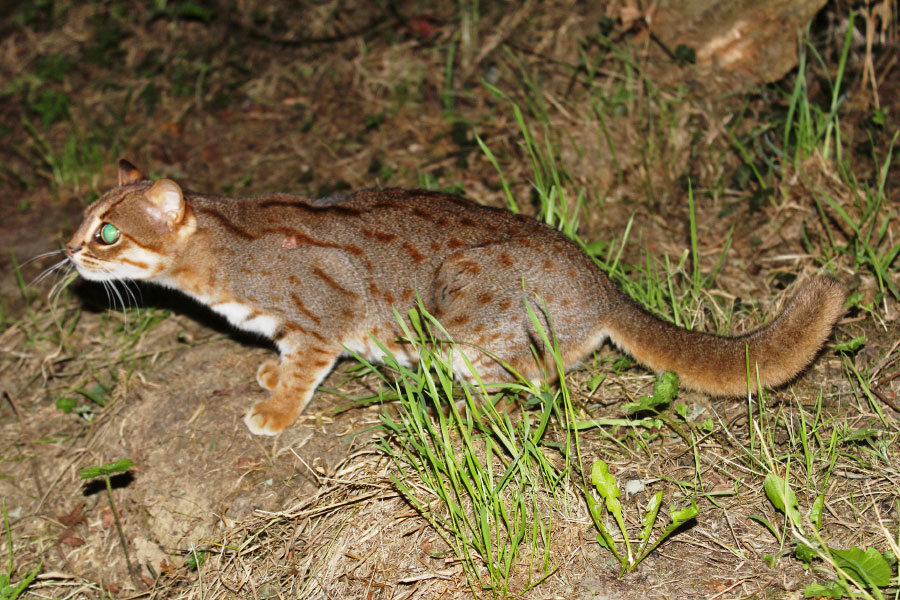
The Northern parts of the Eastern Ghats in Andhra Pradesh are isolated hill ranges with elevations of up to 1500 metres altitude. This landscape complex, with its associated habitats such as dry deciduous forests, riparian buffers, inland freshwater bodies, tropical mangroves, and open scrub, spans across four districts in North Coastal Andhra. Apart from the well-known big cat species like the Tiger and Leopard, these forests are also home to lesser known and often neglected small wild cat species. The four, different species of small wild cats inhabiting the Eastern Ghats are, the Jungle Cat (Felis chaus), the Rusty-spotted cat (Prionailurus rubiginosis) the Fishing Cat (Prionailurus viverrinus) and the Leopard Cat (Prionailurus bengalensis).
The Eastern Ghats Wildlife Society (EGWS) is a non-profit organization which promotes community-based wildlife conservation in the Eastern Ghats region of South India through education, conservation-oriented research, public participation, institutional capacity building and sustainable development. We documented all the four species of wild cats from the region by direct sightings, camera trap records, rescues, dead animals and road kills as well as indirect evidence like tracks, scats and information from semi-structured interviews.
Several seasonal and perennial freshwater bodies traversing through these hill ranges drain into the Bay of Bengal on the eastern side, providing an ideal refuge for wetland-associated species like the Fishing Cat. The species was observed in some dry deciduous forest patches along the coast apart from riparian habitats and mangrove forests. The Rusty-spotted Cat prefers high bushes and thorny scrub jungles while the leopard cat distribution seems confined to higher altitudes. Jungle Cats can be spotted in agricultural fields and human-dominated landscapes.
However, our current efforts focus on addressing the conservation needs of the Fishing Cat and the Rusty-spotted Cat, with an objective to develop a site-specific scientific management plan for conservation of both species, especially in unclassified forests of the Northern Andhra Pradesh region. Both the species are protected legally in India under the Wildlife (Protection) Act, 1972, and have been known to inhabit isolated forest patches outside Protected Areas (PAs).
The Fishing Cat has been documented from multiple locations by our team since 2012. We have been working with local communities to promote conservation of Fishing Cats in human-dominated landscapes across the region. Our threat-reduction programs include community outreach, education and awareness, research on population distribution, assessment of potential threats and devising appropriate intervention strategies. The conservation status of the Fishing Cat is still unclear from the Northern part of Andhra Pradesh as there hasn’t been a systematic survey apart from our earlier sporadic records. The species seems to have been surviving in small pockets along the river banks as well as some wetlands close to human habitations. However, data on the potential threats or their actual impact on the population of the species is lacking.
The Rusty-spotted Cat has been sighted in fragmented hill forests and in agricultural fields at village fringes. We recorded rusty-spotted cat road kills, live sightings and rescues in a patch of dry deciduous forest in Northern Andhra Pradesh. Urbanization is the perhaps the biggest threat to the species in the area since rapid denuding of hills for stone quarrying has been observed. Local people call the cat “Namala Pilli” (in Telugu) – a vernacular term literally meaning “a cat with stripes on the forehead”. Our current project aims at understanding the abundance and distribution of the species, study the potential threats to its survival and promote awareness among all the key stakeholders.
In an effort to bring conservation attention, and foster support to protect these highly ignored small felines, a first ever International Fishing Cat Symposium and an International Small Wild Cat Summit were organized in Nepal and United Kingdom in 2015 and 2017 respectively with support from Mohammed bin Zayed Species Conservation Fund. Various strategies and networking opportunities were explored to enhance the on-going conservation efforts throughout the range countries. Eastern Ghats Wildlife Society presented a case study on the status of the fishing cat and the rusty-spotted cat at these meetings. Furthermore, a presentation highlighting the conservation issues pertaining to small wild cats in the Eastern Ghats was also given at the Cat Summit during Jackson Hole Wildlife Film Festival in Wyoming, USA, by the Eastern Ghats Wildlife Society recently.
All the four small cat species seem to face immense threat from rapid urbanization, habitat loss, fragmentation, direct persecution, road mortalities and retaliatory killings. Besides, bauxite mining, hydroelectric projects and road widening are some of the other direct threats. The fishing cat and jungle cat often run into conflict with humans since they have been known to lift poultry and attack livestock in some locations. Lack of awareness among local people is also a serious impediment to conserve the wild cats and reduce human-induced threats.
Acknowledgements:
I am greatly indebted to Small Wild Cat Conservation Foundation, Wild Oasis, Wildlife Conservation Network and Rufford Foundation for generously supporting my small wild cat projects in the Eastern Ghats. I’m also grateful for the Forest Department of Andhra Pradesh for their help during my education and awareness campaigns.
References:
- Kantimahanti, M. 2016. Community-based Fishing Cat conservation in the Eastern Ghats of South India. In: A. Appel and J. W. Duckworth (eds), Proceedings of the First International Fishing Cat Conservation Symposium, 25–29 November 2015, Nepal. Fishing Cat Working Group, Bad Marienberg, Germany and Saltford, Bristol, United Kingdom. Pp. 51–54.
- Kantimahanti, M. and Surampudi, A. 2016. Small wild cats in the Eastern Ghats of Andhra Pradesh, India. Small Wild Cat Conservation News 2: 7.


 CI is a non-profit, non-commercial portal that aims to facilitate wildlife and nature conservation by providing reliable information and the tools needed to campaign effectively.
CI is a non-profit, non-commercial portal that aims to facilitate wildlife and nature conservation by providing reliable information and the tools needed to campaign effectively.